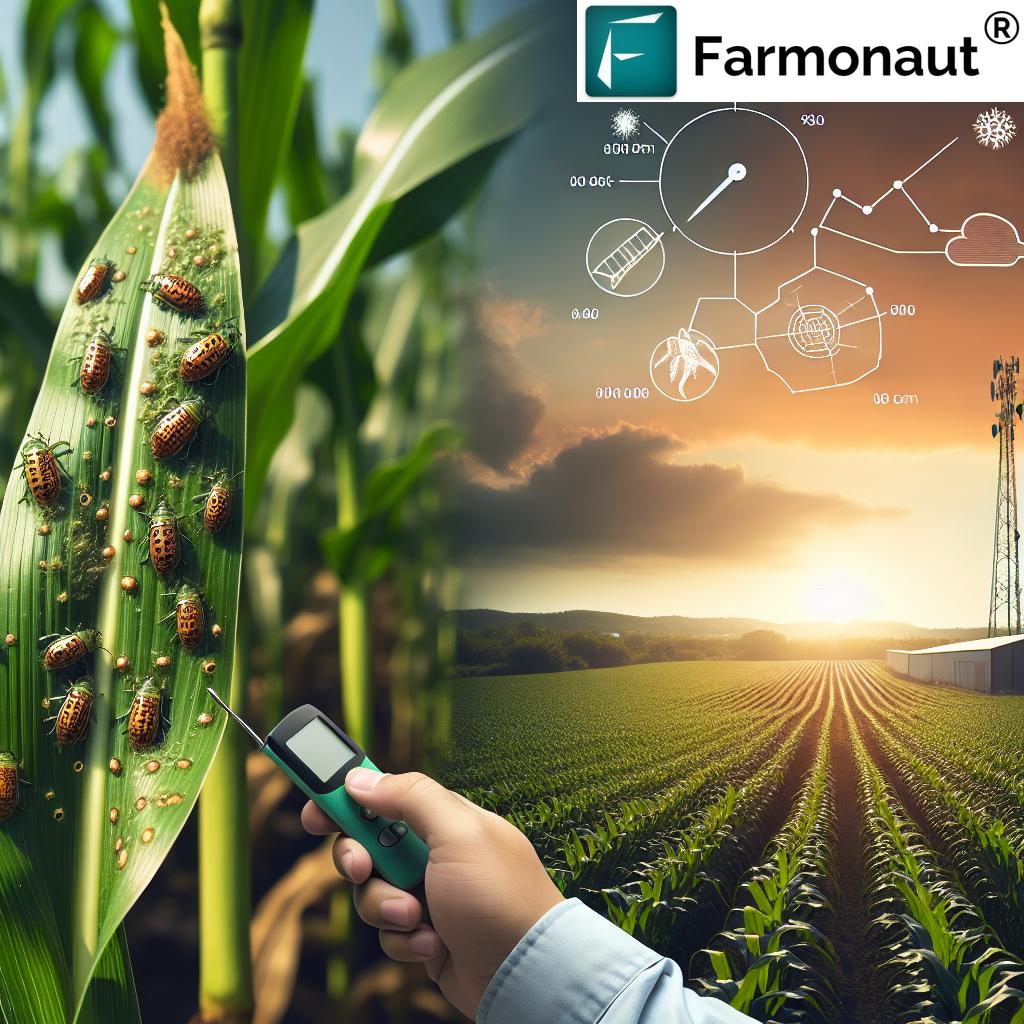Arizona’s Agricultural Boom: How Technology and Trade are Transforming the State’s $30.9 Billion Industry
“Arizona’s agriculture industry saw a 32% increase in economic activity since 2017, reaching $30.9 billion in value.”
In the heart of the American Southwest, a remarkable transformation is taking place. Arizona, known for its stunning deserts and iconic landscapes, is experiencing an unprecedented agricultural boom that’s reshaping the state’s economy and future. We’re witnessing a convergence of innovative technologies, strategic trade relationships, and resilient farming practices that have propelled Arizona’s agricultural sector to new heights. In this comprehensive exploration, we’ll delve into the factors driving this expansion and the challenges that lie ahead for this vital industry.
The Economic Impact of Arizona’s Agricultural Renaissance
The recent study by the University of Arizona’s Agriculture Cooperative Extension has unveiled staggering figures that underscore the significance of agriculture in Arizona’s economic landscape. With an estimated $30.9 billion in economic activity generated by the industry, we’re looking at a sector that’s not just growing but thriving. This 32% increase since 2017 is a testament to the industry’s resilience and adaptability in the face of various challenges.

Several factors have contributed to this impressive growth:
- Inflation: While part of the increase can be attributed to inflationary pressures, it’s clear that the growth extends beyond mere price adjustments.
- Agricultural practice advancements: Subtle yet impactful improvements in farming techniques have boosted productivity across the state.
- Diversification of crops: Arizona’s farmers have expanded their repertoire, introducing new crops and varieties that thrive in the state’s unique climate.
- Technology adoption: The integration of cutting-edge agricultural technologies has played a crucial role in enhancing efficiency and yield.
As we explore these factors in detail, it’s important to recognize the role of innovative solutions in driving this growth. Companies like Farmonaut are at the forefront of this technological revolution, offering satellite-based farm management solutions that are transforming the way Arizona’s farmers operate. Through their  , farmers can access real-time crop health monitoring and AI-based advisory systems, enabling them to make data-driven decisions that optimize their yields and resource management.
, farmers can access real-time crop health monitoring and AI-based advisory systems, enabling them to make data-driven decisions that optimize their yields and resource management.
The Powerhouse of Winter Vegetable Production
One of the cornerstones of Arizona’s agricultural success story is its winter vegetable production. The state’s warm climate and long growing season make it an ideal location for cultivating a wide variety of vegetables when much of the country is blanketed in snow. This sector has seen substantial growth, contributing significantly to the overall economic impact of agriculture in Arizona.
“Nogales and Yuma are key contributors to Arizona’s agricultural success, with winter vegetable production driving significant growth.”
Cities like Yuma and Nogales have emerged as pivotal players in this agricultural renaissance. Yuma, often referred to as the “Winter Vegetable Capital of the World,” produces an astounding 90% of all leafy vegetables grown in the United States from November through March. Meanwhile, Nogales serves as a crucial trade hub, facilitating the exchange of produce between Arizona and Mexico.
The Mexico Connection: A Trade Partnership Driving Growth
The economic expansion of Arizona’s agriculture sector owes much to its strategic trade relationship with Mexico. Professor George Frisvold, a key contributor to the University of Arizona study, highlighted the vital role of this cross-border trade in fueling the industry’s growth, particularly in Southern Arizona.
Nogales stands out as a linchpin in this trade network. As the largest private-sector employer in the region, it plays a critical role in the exchange of produce. This bustling border town not only bolsters the local economy but also ensures a steady supply of winter vegetables to markets across the United States.
The benefits of this trade partnership are multifaceted:
- Year-round produce availability: The trade relationship ensures a consistent supply of fresh fruits and vegetables, even during off-seasons in the U.S.
- Job creation: The trade activities support a significant number of jobs in logistics, transportation, and related services.
- Economic diversification: The robust trade helps to diversify Arizona’s economy, reducing dependence on any single sector.
- Cultural exchange: The close economic ties foster cultural understanding and cooperation between Arizona and Mexico.
To support these trade activities and enhance agricultural productivity, innovative technologies play a crucial role. Farmonaut’s satellite-based solutions offer valuable insights for both Arizona farmers and their Mexican counterparts, helping to optimize crop production and streamline supply chains across borders.
Beyond Vegetables: Arizona’s Diverse Agricultural Landscape
While winter vegetables are a significant component of Arizona’s agricultural success, the state’s agricultural portfolio is remarkably diverse. Let’s explore some of the other sectors contributing to this economic powerhouse:
The Budding Wine Industry
Arizona’s wine industry has been gaining recognition in recent years. With regions like Sonoita, Willcox, and Verde Valley producing award-winning wines, this sector is not just contributing to the state’s agricultural output but also boosting tourism and enhancing Arizona’s reputation in the culinary world.
Tribal Agricultural Production
Native American tribes in Arizona have long been integral to the state’s agricultural heritage. Today, tribal lands are seeing a resurgence in agricultural activities, with a focus on sustainable practices and traditional crops. This sector not only contributes to the state’s economy but also plays a vital role in preserving cultural traditions and promoting food sovereignty.
Livestock and Dairy
Arizona’s rangelands support a thriving livestock industry, with cattle ranching being a significant contributor. Additionally, the state’s dairy sector has seen steady growth, supplying milk and dairy products to local and regional markets.
Cotton and Field Crops
Despite the challenges posed by water scarcity, Arizona continues to be a significant producer of cotton and other field crops. The adoption of drought-resistant varieties and efficient irrigation techniques has helped maintain this sector’s viability.
As we can see, the diversity of Arizona’s agricultural sector is one of its greatest strengths. This variety not only helps to buffer against market fluctuations but also positions the state as a key player in multiple agricultural markets.
Challenges on the Horizon: Water Scarcity and Labor Availability
While Arizona’s agricultural industry is thriving, it’s not without its challenges. Two of the most pressing issues facing farmers in the state are water scarcity and labor availability.
The Water Conundrum
Water availability is a critical concern, especially in the state’s central regions that rely heavily on Colorado River water. With ongoing supply cuts and the effects of climate change, farmers are facing increasing pressure to do more with less water. This challenge has spurred innovation in irrigation management and water conservation techniques.
Some strategies being employed to address water scarcity include:
- Drip irrigation systems: These systems deliver water directly to plant roots, minimizing evaporation and runoff.
- Crop selection: Farmers are increasingly opting for drought-resistant crop varieties that require less water.
- Water recycling: Advanced water treatment technologies are allowing for the reuse of water in agricultural operations.
- Precision agriculture: Technologies like those offered by Farmonaut help farmers optimize water usage by providing detailed insights into soil moisture levels and crop water needs.
Farmonaut’s satellite-based crop health monitoring system is particularly valuable in this context. By providing real-time data on vegetation health and soil moisture levels, it enables farmers to make informed decisions about irrigation, reducing water waste while maintaining crop health. Learn more about these solutions through their API Developer Docs.
The Labor Challenge
Labor availability is another pressing issue for Arizona’s agricultural sector. The industry’s productivity is closely tied to its workforce, and securing a reliable labor force has become increasingly challenging. This issue is particularly acute during harvest seasons when the demand for workers peaks.
The labor challenge is multifaceted, involving factors such as:
- Immigration policies: Changes in immigration laws and enforcement can affect the availability of seasonal workers.
- Competing industries: Other sectors, such as construction and hospitality, often compete for the same pool of workers.
- Aging farmer population: As older farmers retire, there’s a need to attract younger generations to agriculture.
- Skill gaps: The increasing technologization of farming requires workers with new skill sets.
To address these challenges, various strategies are being employed:
- Mechanization: Investing in automated harvesting and planting equipment to reduce labor needs.
- Worker training programs: Developing initiatives to train local workers in agricultural skills and technologies.
- Guest worker programs: Collaborating with government agencies to facilitate legal temporary worker programs.
- Technology adoption: Implementing technologies that can help optimize workforce management and increase productivity.

In this context, Farmonaut’s technology plays a crucial role. By providing farmers with detailed insights into their crops and fields, it allows for more efficient allocation of labor resources. Farmers can prioritize areas that need immediate attention, reducing the overall labor requirements while maintaining productivity. The company’s mobile applications ( and
and  ) make this technology accessible to farmers in the field, further enhancing its impact on labor management.
) make this technology accessible to farmers in the field, further enhancing its impact on labor management.
The Role of Technology in Shaping Arizona’s Agricultural Future
As we look to the future of Arizona’s agriculture, it’s clear that technology will play a pivotal role in addressing challenges and driving continued growth. From precision agriculture to blockchain-based traceability, innovative solutions are transforming every aspect of farming in the state.
Precision Agriculture: Maximizing Efficiency
Precision agriculture technologies are helping Arizona farmers optimize their operations in several ways:
- Satellite imagery: Companies like Farmonaut provide high-resolution satellite imagery that allows farmers to monitor crop health, detect pest infestations, and identify areas of stress in their fields.
- IoT sensors: Internet of Things (IoT) devices placed throughout fields provide real-time data on soil moisture, temperature, and other critical factors.
- Drones: Unmanned aerial vehicles are used for detailed field mapping, crop spraying, and monitoring hard-to-reach areas.
- AI and machine learning: Advanced algorithms analyze data from various sources to provide actionable insights and predictions.
These technologies not only improve yields but also help conserve resources, reduce environmental impact, and increase overall farm profitability.
Sustainable Farming Practices
Arizona’s agricultural sector is increasingly embracing sustainable farming practices, driven by both environmental concerns and economic benefits:
- Conservation tillage: Minimizing soil disturbance to improve soil health and reduce erosion.
- Cover cropping: Planting cover crops to improve soil fertility and prevent erosion during fallow periods.
- Integrated pest management: Using a combination of biological controls and targeted pesticide application to minimize chemical use.
- Renewable energy: Incorporating solar and wind power into farm operations to reduce reliance on fossil fuels.
Farmonaut’s technology supports these sustainable practices by providing farmers with the data they need to make informed decisions about resource use and environmental impact.
Blockchain and Traceability
As consumers become increasingly interested in the origins of their food, blockchain technology is emerging as a powerful tool for ensuring transparency in the agricultural supply chain. This technology allows for the tracking of produce from farm to table, providing verifiable information about:
- Origin of products
- Farming practices used
- Transportation and storage conditions
- Certifications (organic, fair trade, etc.)
By implementing blockchain-based traceability solutions, Arizona’s agricultural sector can enhance consumer trust, improve food safety, and potentially access premium markets for verified sustainably-produced goods.
The Economic Ripple Effect: Beyond the Farm
The impact of Arizona’s agricultural boom extends far beyond the fields and orchards. With approximately 160,000 workers employed in the industry, agriculture is a significant driver of employment in the state. But the economic effects ripple out even further, touching various sectors of the economy:
- Wholesaling: The distribution and sale of agricultural products support a robust wholesaling sector.
- Manufacturing: Food processing and agricultural equipment manufacturing benefit directly from the agricultural boom.
- Transportation and logistics: Moving produce from farms to markets requires a complex network of transportation services.
- Research and development: Universities and private companies invest in agricultural research, driving innovation in the sector.
- Tourism: Agritourism, including winery tours and farm stays, is an emerging sector benefiting from the agricultural renaissance.
This interconnectedness highlights the crucial role that agriculture plays in Arizona’s overall economic health and underscores the importance of supporting the industry’s continued growth and innovation.
Looking Ahead: The Future of Arizona Agriculture
As we look to the future, several trends and developments are likely to shape the trajectory of Arizona’s agricultural sector:
- Climate adaptation: With climate change presenting ongoing challenges, Arizona farmers will need to continue adapting their practices and crop selections to thrive in changing conditions.
- Technological integration: The adoption of advanced technologies like AI, robotics, and IoT is expected to accelerate, further enhancing productivity and sustainability.
- Market diversification: Arizona’s agricultural sector may explore new markets, both domestically and internationally, to reduce dependence on any single market.
- Value-added products: There may be increased focus on developing value-added agricultural products to capture more of the value chain within the state.
- Sustainable water management: Innovative approaches to water conservation and management will be crucial for the long-term viability of agriculture in the state.
Companies like Farmonaut are poised to play a crucial role in this future, providing the technological backbone that will enable farmers to navigate these challenges and opportunities. Their satellite-based solutions and AI-driven insights will be invaluable tools for farmers looking to optimize their operations in an increasingly complex agricultural landscape.
Economic Impact of Arizona’s Agricultural Sectors
| Agricultural Sector | Estimated Economic Value (in billions) | Percentage Growth Since 2017 | Key Production Areas | Major Challenges | Technological Innovations |
|---|---|---|---|---|---|
| Winter Vegetable Production | $8.5 | 35% | Yuma, Nogales | Water scarcity, Labor availability | Precision irrigation, Automated harvesting |
| Wineries | $1.2 | 28% | Sonoita, Willcox, Verde Valley | Climate variability, Market competition | Smart vineyard management systems, Blockchain for authenticity |
| Tribal Agriculture | $2.3 | 22% | Various tribal lands | Water rights, Access to markets | Drought-resistant crop varieties, Satellite crop monitoring |
| Livestock and Dairy | $5.8 | 30% | Statewide | Feed costs, Environmental regulations | AI-driven herd management, Sustainable waste management |
| Cotton and Field Crops | $3.1 | 18% | Central Arizona | Water scarcity, Price fluctuations | Precision agriculture, Genetically optimized crops |
Frequently Asked Questions
- Q: What is driving the growth of Arizona’s agricultural sector?
A: The growth is driven by factors including winter vegetable production, strategic trade with Mexico, technological innovations, and diversification of crops. - Q: How significant is the economic impact of agriculture in Arizona?
A: As of the latest study, Arizona’s agriculture industry generates $30.9 billion in economic activity, representing a 32% increase since 2017. - Q: What role does technology play in Arizona’s agricultural success?
A: Technology plays a crucial role, with innovations like precision agriculture, satellite-based crop monitoring, and AI-driven advisory systems improving efficiency and productivity. - Q: What are the main challenges facing Arizona’s agricultural industry?
A: The primary challenges include water scarcity, labor availability, climate change adaptation, and market competition. - Q: How important is the trade relationship with Mexico for Arizona’s agriculture?
A: The trade relationship with Mexico is vital, particularly for Southern Arizona, facilitating the exchange of produce and supporting significant employment in border regions like Nogales.
Conclusion: A Bright Future for Arizona Agriculture
Arizona’s agricultural boom is a testament to the resilience, innovation, and adaptability of the state’s farming community. Despite facing significant challenges such as water scarcity and labor shortages, the industry has not only persevered but thrived, contributing $30.9 billion to the state’s economy and supporting 160,000 jobs.
The success of Arizona’s agriculture sector is built on a foundation of strategic advantages, including its climate for winter vegetable production, strong trade relationships with Mexico, and the adoption of cutting-edge technologies. Companies like Farmonaut are playing a crucial role in this technological revolution, providing farmers with the tools they need to optimize their operations and navigate the challenges of modern agriculture.
As we look to the future, the continued integration of sustainable practices, advanced technologies, and innovative solutions will be key to maintaining this growth trajectory. With its diverse agricultural portfolio, from vegetables and cotton to emerging sectors like wineries and tribal production, Arizona is well-positioned to remain a powerhouse in the national and global agricultural landscape.
The story of Arizona’s agricultural boom is one of transformation, resilience, and innovation. It’s a narrative that extends beyond the fields and orchards, touching every corner of the state’s economy and community. As we move forward, the continued success of this vital industry will depend on the collective efforts of farmers, technologists, policymakers, and communities working together to build a sustainable and prosperous agricultural future for Arizona.










